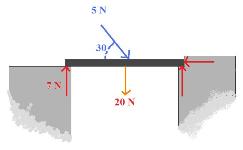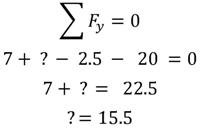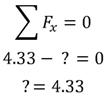LESSON 2: Sum of Forces 2

To begin this problem you should break the angled vector (blue) into its component parts. So, this 5 N vector is the same as having two vectors; one 4.33 N vector in the x-direction and one 2.5 N vector in the y-direction.



Now letís sum the forces in the x-direction. In the x-direction there are two forces, one going to the right and one going to the left. In order for the bar to remain static, these two forces must be equal. We know the force to the right is 4.33 N, so the unknown force going to the left must also be 4.33 N.

Tutorial Options:
Return to Home Page
Statics Lessons Home Page
Statics Example Problems
Continue to Next Section
Return to Home Page
Statics Lessons Home Page
Statics Example Problems
Continue to Next Section
Lesson 1:
Vectors
Magnitude
Unit Vectors
Cos Angles
Lesson 2:
Sum of Forces
Sum of Forces 2
Lesson 3:
3D Sum of Forces
Lesson 4:
Moments
Moments 2
Lesson 5:
Trusses
Method of Joints
Method of Sections
Lesson 6:
Distributed Load
Vectors
Magnitude
Unit Vectors
Cos Angles
Lesson 2:
Sum of Forces
Sum of Forces 2
Lesson 3:
3D Sum of Forces
Lesson 4:
Moments
Moments 2
Lesson 5:
Trusses
Method of Joints
Method of Sections
Lesson 6:
Distributed Load